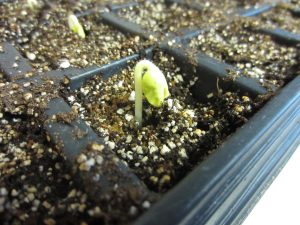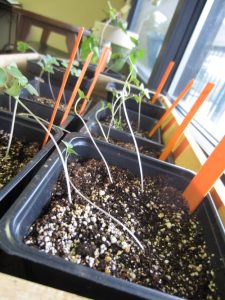
By Heather N. Kolich, ANR Agent, UGA Extension Forsyth County
As gardeners, we’re counting down the days to spring planting. With some planning and a bit of equipment, we can expand our plant options and save some money by growing plants from seeds indoors now.
Many garden annuals grow easily from seeds, but some are more reliable and productive when added to garden beds as transplants. Growing from seeds provides more cultivar options than purchasing transplants, which are typically limited to a few popular varieties. Plus, successfully propagating seeds yields several plants for the same cost as purchasing one transplant.
Seeds for plants like tomatoes, peppers, herbs, and bedding flowers should be propagated indoors and grown for at least six weeks before they’re planted outdoors in mid to late April. Because seeds may require 1-3 weeks to germinate, starting the propagation process in February assures they’ll be ready for spring planting. Some seeds are available to be “checked out” at seed libraries in the Cumming and Hampton Park branches of the Forsyth County Public Libraries. The seed libraries are a joint project with Forsyth County Extension Master Gardeners.
How to Propagate Seeds Indoors
Getting seeds up and growing requires meeting the physical needs of temperature (65°F-85°F for most warm-season plants) and moisture that stirs them out of dormancy. As soon as seedlings pop up through the soil mix, they need long hours of bright light. Basic materials for seed propagation include a seeding tray with small growing cells; loose, lightweight seed starting soil mix; a water catch tray; a warm location; and supplemental lighting. Seedling heat mats warm the seed starting mix more economically than cranking up the thermostat and more conveniently than putting the germination tray on top of the refrigerator. Basic seedling heat mats start around $20; those with temperature control features start around $50.
To successfully complete the germination process, seeds need to stay moist until seedlings push through the soil line. The small volume of soil mix in germination trays allows better control of soil moisture than is possible with larger volumes of soil.
Once seedlings are up, water the plants by pouring water into the catch tray and let the soil mix absorb it upward from the bottom. Allow the top of the soil to dry between watering; constant moisture around seedling stems will rot them and kill the plants. Watering from the bottom also keeps leaves dry, an important factor in preventing fungus outbreaks.
Provide supplemental lighting from the moment seedlings appear. Sunlight from a window is rarely enough light – in strength or length – to grow sturdy, healthy plants. An economical option is to construct a stand from sturdy PVC pipe and suspend a fluorescent shop light from it using O-rings, S-hooks, and chains. Keep the light 2-4 inches above the plants for 14-16 hours daily, raising the light on the chain as the plants grow.
As plants outgrow the small starter cells, transfer them to 4-inch pots with a growth soil mix. Fertilize the plants very lightly with one-quarter strength water-soluble fertilizer. Continue to provide 12-16 hours of supplemental light daily and water from the bottom as needed to keep the soil moist 1-inch below the soil surface.

Transplanting to Garden
We’re generally considered to be past frost danger after April 15 in North Georgia. Preparing seedlings for life outdoors is a several-day process called “hardening off.”
On day one, place plants outside for one hour either in the morning, on a cloudy day, or in a shaded spot, then bring them back inside to their artificial light. Repeat daily, adding one hour outside each day until the plants are acclimated to full sunlight.
To transplant, water the plants and the garden beds well. Space plants far enough apart to accommodate their mature size without crowding. Plant transplants at the same level or slightly above where they grew in the pots. (Exception: tomatoes can be planted more deeply.) Sprinkle some slow-release fertilizer on the soil around the plants, water it in, and cover the soil with mulch. Then enjoy your garden blooms and bounty.